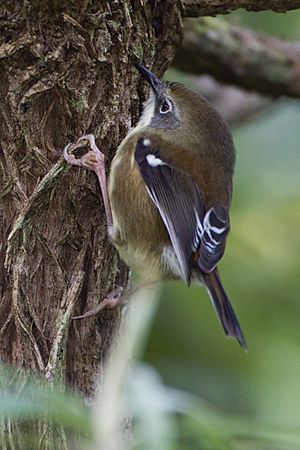Scrubtit facts for kids
The scrubtit (Acanthornis magna) is a small bird that lives only in Tasmania and King Island in Australia. It belongs to the thornbill family, which includes many small, active birds. Scrubtits like to live in cool, wet forests, especially those with beech trees (called Nothofagus) and eucalypt woodlands. It looks a bit like the scrubwrens, which are other small birds.
Quick facts for kids Scrubtit |
|
|---|---|
 |
|
| Conservation status | |
| Scientific classification | |
| Genus: |
Acanthornis
|
| Species: |
magna
|
| Subspecies | |
|
|
| Synonyms | |
|
Acanthornis magnus |
|
Contents
About the Scrubtit's Family Tree
Scientists group living things into families, just like your own family tree! This is called Taxonomy. The scrubtit is special because it's the only bird in its group, called the genus Acanthornis.
A study in 2017 looked at the scrubtit's DNA. They found that the scrubtit's ancestors separated from another group of birds, called whitefaces, about 7 million years ago. Before that, their shared ancestors separated from the thornbill family about 13 million years ago.
What Does the Scrubtit Look Like?
The scrubtit is a small bird, usually about 11 to 12 centimetres (4.33 to 4.72 in) long. That's about the length of your hand! It weighs around 10 grams (0.35 oz), which is about the same as two quarters.
Its feathers are mostly brown on its back, head, and tail. Its belly and throat are white, and its sides are also brown. Its wings are black, and its face is grey. The scrubtit has pale eyes and a short, black, slightly curved beak.
These birds are often quiet, but they do make loud calls to talk to each other. They also have a beautiful, musical song.
Scrubtit Behaviour and Life Cycle
How Scrubtits Find Food
Scrubtits usually look for food alone, in pairs, or in small family groups. They stay close to the ground, hidden in thick bushes and plants. They mostly eat small bugs and their eggs. Sometimes, scrubtits will join other types of birds to look for food together in what are called mixed-species feeding flocks.
Nesting and Raising Young
Scrubtits are monogamous, meaning a pair stays together. They also protect their own area, or territory. Their breeding season is from September to January.
The nest is shaped like a ball and is woven from plant material. It has a small opening on the side. Inside, the nest is soft, lined with feathers and fur. Scrubtits hide their nests well, usually about 1 to 3 meters (3 to 10 feet) off the ground.
A female scrubtit usually lays three eggs, but sometimes four. The eggs are about 18 by 15 millimetres (0.71 by 0.59 in) in size. They are shiny white with small reddish spots, especially at the wider end. We don't know much about how long the eggs take to hatch or how long the baby birds stay in the nest. Both parents help feed the chicks.
Challenges for Young Scrubtits
Sometimes, other birds, like fan-tailed cuckoos and shining bronze-cuckoos, will lay their eggs in a scrubtit's nest. This is called brood parasitism. The scrubtit parents then raise the cuckoo chicks, sometimes without knowing they aren't their own. Also, small meat-eating animals called quolls sometimes eat scrubtit eggs and baby birds.
Scrubtit Conservation
The scrubtit lives in a small area, but it is not considered threatened overall by the IUCN. This group checks on how many animals are left in the wild.
However, the scrubtit subspecies that lives on King Island is in serious trouble. It is considered critically endangered, meaning it's very close to disappearing forever. Scrubtits are shy birds and are not often seen by people.
See also
 In Spanish: Sedosito tasmano para niños
In Spanish: Sedosito tasmano para niños


